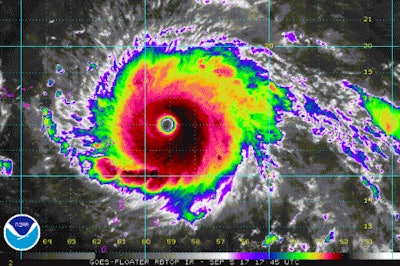
With government and commercial fleets emerging from the coronavirus pandemic, another threat is here: hurricane season, which officially started June 1.
A fleet manager with experience preparing for and executing in the aftermath of a hurricane stresses the importance of equipment and technology being ready for the time of need.
During the past few years, the City of Lakeland, Florida, has dispatched vehicles and workers as far as New York and New Jersey for Hurricane Sandy for mutual aid. It has also sent vehicles and workers to Puerto Rico in the aftermath of Hurricane Maria in September 2017.
“Anytime anything hits, our folks are usually deployed,” said Lakeland’s fleet manager Gary McLean. The city has a fleet of 1,400 vehicles and an office staff of 28 people.
In September 2017, Hurricane Irma hit Lakeland as a Category 3 storm. The city’s traffic grid was knocked down, and the ability to instantly track vehicles and workers became critical.
The city used its Verizon Connect platform to eliminate phone calls that would have created additional safety hazards for workers due to distractions. The office monitored workers’ progression on routes and sent text messages to their phones with links to locations on a digital map that showed where generators needed fuel to ensure traffic lights and other essential services had power.
The city’s water utility fleet also used the platform to route vehicles to customer locations by using the mapping feature to locate the closest truck to jobs, he said.
A possible technology upgrade for Lakeland would be to invest in hardened tablets for the platform. McLean joked that he may purchase them this year by siphoning some money from his fuel budget and “ask for forgiveness later.”
Investing in tablets for the Verizon Connect platform is not on the same level of priority as getting equipment ready, such as fuel tankers, generators and refrigerated trailers, he said. By using the technology, the fleet has been monitoring diagnostic data and acting early on maintenance needs.
Perhaps the biggest change in fleets’ contingency planning for hurricane season this year is that much of the workforce is still working remotely. Verizon Connect suggested the following steps for business and government organizations to prepare:
- Make sure contact information is updated and readily available for all employees
- Make copies of insurance documents, review insurance coverages and update as appropriate
- Ensure employees working from home have documented all corporate equipment being used to work from home in case of damage or loss
- Have a backup plan to shift work in case work-from-home employees in a storm-impacted area have to evacuate their home or their home loses commercial power
Verizon also released a document that summarizes preparations it has made to ensure its network is ready:
- A 24/7 Verizon Response Team (VRT) to coordinate with first responders to provide essential technologies
- COVID-19 considerations to ensure personal equipment and processes are in place for field teams who may have to enter highly populated areas like shelters or operations centers
- Redundancy with backup generators, HVAC systems and redundant fiber rings for cell sites and switching centers to keep the network running and customers connected when commercial power is lost, or water damage occurs
- Pre-arranged fuel deliveries for generators in case of a storm
- Surveillance drones on standby to help assess and respond to damage from a storm, and to deliver wireless service to a designated area from the sky
- A fleet of satellite-equipped portable cell sites if fiber or microwave is damaged
This story was written by Commercial Carrier Senior Editor Aaron Huff.








